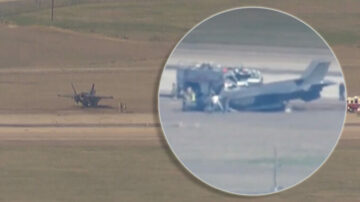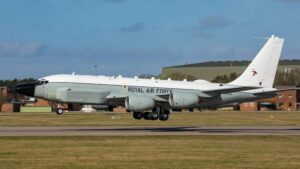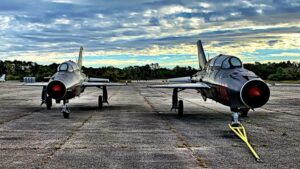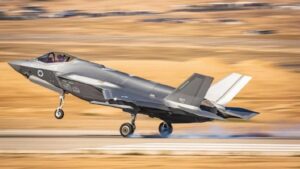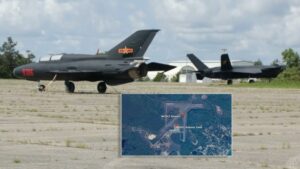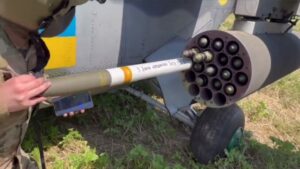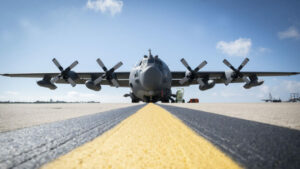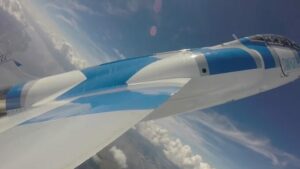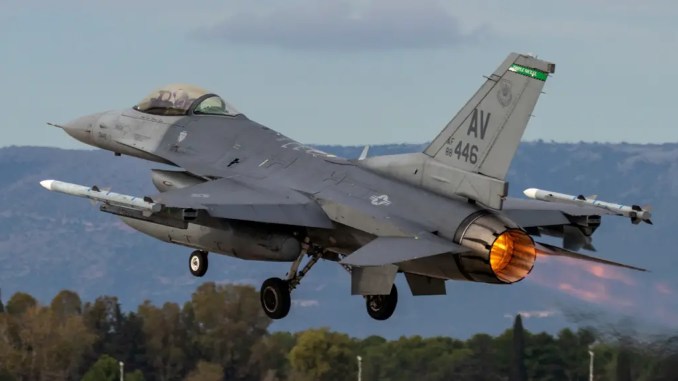
The U.S. F-16 fleet is undergoing the largest modification work in history with the Post Block Integration Team.
Now that the F-16 is 50, it is fitting to talk about its future and how it will stay up to date with the capabilities required to face current and future threats. In fact, although the U.S. Air Force is retiring the older aircraft, the newer Block 40 and Block 50 aircraft are expected to fly well into the 2040s and, to do that, they will need to be upgraded.
A total of 608 Block 40 and Block 50 aircraft, the so-called “Post Block” F-16s, will be upgraded through the Post Block Integration Team (PoBIT) project managed by the Air Force Life Cycle Management Center’s Fighters and Advanced Aircraft Directorate. The project includes up to 22 modifications designed to improve lethality and ensure the fourth-generation fighter remains effective in meeting current and future threats.
“Providing this capability on an already time- and combat-proven aircraft adds another layer to U.S. Air Force capabilities in an ever-evolving electronic warfare environment,” said the then Air Force Chief of Staff Gen. CQ Brown, Jr. “I know this upgrade will make us even more effective in our day-to-day combat operations, and I look forward to bringing the F-16 even further into the future of air superiority.”
Launched in 2022, the PoBIT upgrades are being performed in conjunction with the Service Life Extension Program (SLEP) which will extend the airframes’ fatigue life from 8,000 to 12,000 hours. The SLEP will replace structural bulkheads and longerons, modify wing and wing-box assemblies, install new structural brackets and beam supports and reskin the upper fuselage. The depot work for the entire process takes up to nine months for each Viper and is being performed at multiple locations both in the United States and in Europe.
The main feature of the PoBIT upgrade is the installation of the APG-83 Scalable Agile Beam Radar (SABR) with Active Electronically Scanned Array and the Center Display Unit (CDU), technology that ultimately gives the F-16 and its pilot a clearer vision of the threat picture to increase both the survivability and accuracy of the weapon system. The updated F-16 radar systems allow pilots to use Synthetic Aperture Radar mapping to detect and deploy weapons against air-to-air and air-to-ground threats at much longer ranges.
A U.S. Air Force F-16CM Fighting Falcon from the 480th Fighter Squadron flies over Germany April 13, 2022, after completing installation of a new active electronically scanned array (AESA) radar system. Adding AESA to the 480th FS Warhawks’ arsenal further augments the Air Force’s and combatant commanders’ ability to respond to a wider range of threats in the region. (U.S. Air Force photo by Staff Sgt. Chanceler Nardone)
" data-medium-file="https://i0.wp.com/theaviationist.com/wp-content/uploads/2024/01/F-16_Post_Block_Integration_Team_Upgrades_2.jpg?fit=460%2C257&ssl=1" data-large-file="https://i0.wp.com/theaviationist.com/wp-content/uploads/2024/01/F-16_Post_Block_Integration_Team_Upgrades_2.jpg?fit=706%2C394&ssl=1" decoding="async" class="size-large wp-image-84721" src="https://platoaistream.com/wp-content/uploads/2024/01/how-the-u-s-air-force-will-keep-its-f-16s-flying-into-the-2040s-1.jpg" alt width="706" height="394" srcset="https://platoaistream.com/wp-content/uploads/2024/01/how-the-u-s-air-force-will-keep-its-f-16s-flying-into-the-2040s-1.jpg 706w, https://platoaistream.com/wp-content/uploads/2024/01/how-the-u-s-air-force-will-keep-its-f-16s-flying-into-the-2040s-3.jpg 460w, https://platoaistream.com/wp-content/uploads/2024/01/how-the-u-s-air-force-will-keep-its-f-16s-flying-into-the-2040s-4.jpg 128w, https://platoaistream.com/wp-content/uploads/2024/01/how-the-u-s-air-force-will-keep-its-f-16s-flying-into-the-2040s-5.jpg 768w, https://i0.wp.com/theaviationist.com/wp-content/uploads/2024/01/F-16_Post_Block_Integration_Team_Upgrades_2.jpg?w=1024&ssl=1 1024w" sizes="(max-width: 706px) 100vw, 706px" data-recalc-dims="1">Other upgrades include Link 16, modernizing the cockpit and main mission computer, and converting the fleet to a high-speed data network, as well as next-generation electronic warfare capability, a Communication Suite Upgrade, a Programmable Data Generator and several other key hardware components. PoBIT upgrades for the F-16 fleet are being conducted in various phases to provide the aircraft the necessary updates while ensuring operational requirements can still be met.
The oldest “Post Block” F-16s in service are the Block 40/42s that began rolling off the Fort Worth production line in late 1988, while the newest F-16 is a Block 50 delivered in March 2005. The largest upgrade before PoBIT was the Common Configuration Implementation Program, a huge mid-life upgrade effort that ran from 2000 until 2010 and essentially brought 651 Block 40/42/50/52 variants to a common standard with a host of improvements including new mission computers, updated cockpit displays and data links.
Subsequent upgrade plans were focused on a much-needed AESA radar for the F-16s, although the first attempts did not materialize. Then a U.S. Northern Command Joint Emergent Operational Need (JEON) for a radar upgrade for Pre-Block (Block 30/32) Air National Guard F-16s for the Homeland Defense mission resulted in the Air Force choosing the Northrop Grumman AN/APG-83 SABR and, after successful fielding with the ANG, it was decided to equip with the same radar also the active duty F-16s.
According to Northrop Grumman, the radar is designed to fit the F-16 with no structural, power or cooling modifications; in addition, it enables the F-16 to detect, track and identify a greater number of targets (reportedly more than 20 at the same time) faster and at longer ranges while providing all-weather, high-resolution Synthetic Aperture Radar (SAR) mapping. The system also integrated a robust electronic protection to operate in hostile electronic environments.
Another upgrade that was first installed on ANG jets is the CDU, which was added in the F-16’s cockpit in 2013, well before the new AESA radar. The CDU replaces the instruments located on the center pedestal with a 6 by 8 inches multi-function high resolution color display and allows not only to take full advantage of the new radar and upgraded targeting pods, but also to reduce the pilot’s workload and increase safety and efficiency.
As part of PoBIT, the Northrop Grumman AN/ALQ-257 Integrated Viper Electronic Warfare Suite is replacing the legacy electronic warfare systems, providing a next generation EW system that is internal to the F-16 and fully interoperable with the new on-board APG-83 radar. IVEWS is designed to Open Missions Systems requirements and provisioned for long-term growth capability to support future upgrades such as the Fiber Optic Tow Decoy, Adaptive/Cognitive Processing, and Open System Architecture compliance.
U.S. Air Force Airman 1st Class Kylie Robey, 52nd Aircraft Maintenance Squadron F-16 avionics apprentice, works to install a new active electronically scanned array (AESA) radar system onto a 480th Fighter Squadron F-16C Fighting Falcon at Spangdahlem Air Base, Germany, May 20, 2022. The AESA upgrade provides F-16s a massive leap in combat capabilities, making pilots even more effective than ever before while improving air defenses and overall aircraft survivability when faced with enemy forces. (U.S. Air Force photo by Tech. Sgt. Maeson L. Elleman)
" data-medium-file="https://i0.wp.com/theaviationist.com/wp-content/uploads/2024/01/F-16_Post_Block_Integration_Team_Upgrades_3.jpg?fit=460%2C306&ssl=1" data-large-file="https://i0.wp.com/theaviationist.com/wp-content/uploads/2024/01/F-16_Post_Block_Integration_Team_Upgrades_3.jpg?fit=706%2C470&ssl=1" decoding="async" loading="lazy" class="size-large wp-image-84722" src="https://platoaistream.com/wp-content/uploads/2024/01/how-the-u-s-air-force-will-keep-its-f-16s-flying-into-the-2040s-2.jpg" alt width="706" height="470" srcset="https://platoaistream.com/wp-content/uploads/2024/01/how-the-u-s-air-force-will-keep-its-f-16s-flying-into-the-2040s-2.jpg 706w, https://platoaistream.com/wp-content/uploads/2024/01/how-the-u-s-air-force-will-keep-its-f-16s-flying-into-the-2040s-6.jpg 460w, https://platoaistream.com/wp-content/uploads/2024/01/how-the-u-s-air-force-will-keep-its-f-16s-flying-into-the-2040s-7.jpg 128w, https://platoaistream.com/wp-content/uploads/2024/01/how-the-u-s-air-force-will-keep-its-f-16s-flying-into-the-2040s-8.jpg 768w, https://i0.wp.com/theaviationist.com/wp-content/uploads/2024/01/F-16_Post_Block_Integration_Team_Upgrades_3.jpg?w=1024&ssl=1 1024w" sizes="(max-width: 706px) 100vw, 706px" data-recalc-dims="1">The ALQ-257 IVEWS is a completely internal electronic warfare suite, incorporating all Electronic Warfare functionality, including jamming of current and future threats. This means that it incorporates all functions previously performed by the ECM pods, freeing the F-16’s centerline station from the ALQ-131 and ALQ-184 pods and allowing it to be used for the 300 gal external fuel tank or other payloads.
IVEWS also includes a Radar Warning Receiver, however this aspect of the PoBIT upgrade is a bit unclear as the Air Force also had a contract with Raytheon for the supply of at least 779 ALR-69A(V) all-digital radar warning receiver for the F-16, KC-46 and C-130H, replacing the legacy ALR-69 and ALR-56M. The system was designed as a drop-in replacement, using the same location of the existing receivers, processor and antennas, and can also provide threat geolocation.
This is just a part of the many upgrades that the Viper is receiving, as many have not yet been disclosed. However, we should not that they might not be the last, as technology is continuously evolving. Also, there are some new systems being introduced on ANG F-16s, such as the ASQ-236 Dragon’s Eye AESA radar pod, a tactical Ku-band system which provides detailed maps for surveillance, coordinate generation and bomb impact assessments and complements the APG-83.
ANG jets have also improvement in the countermeasures, such as the already operational weapon pylons on stations 3 and 7 fitted with Terma’s Pylon Integrated Dispenser System, improving chaff and flare countermeasures dispenser capacity. A contract signed in 2020 will deliver new Pylon Integrated Dispensing System Universal (PIDSU) with three chaff/flare dispenser magazines each, EW core pylons with provisions for future Missile Warning System installation, Flare-Up kits and test adapters.
The U.S. Air National Guard has issued a “fielding recommendation” for Leonardo’s BriteCloud 218 Expendable Active Decoy and has subsequently designated it as AN/ALQ-260(V)1, identifying BriteCloud as an airborne electronic warfare countermeasure. BriteCloud is a battery powered, self-contained cartridge that provides an off-board jamming capability that can be dropped like the classic chaffs and flares, creating a large distance between the aircraft and the decoy so the missile and its shrapnel miss completely the aircraft.
- SEO Powered Content & PR Distribution. Get Amplified Today.
- PlatoData.Network Vertical Generative Ai. Empower Yourself. Access Here.
- PlatoAiStream. Web3 Intelligence. Knowledge Amplified. Access Here.
- PlatoESG. Carbon, CleanTech, Energy, Environment, Solar, Waste Management. Access Here.
- PlatoHealth. Biotech and Clinical Trials Intelligence. Access Here.
- Source: https://theaviationist.com/2024/01/24/usaf-to-fly-f-16s-into-the-2040s/?utm_source=rss&utm_medium=rss&utm_campaign=usaf-to-fly-f-16s-into-the-2040s
- :has
- :is
- :not
- $UP
- 000
- 1
- 12
- 125
- 13
- 1st
- 20
- 2000
- 2005
- 2010
- 2013
- 2020
- 2022
- 22
- 300
- 40
- 50
- 7
- 8
- a
- ability
- About
- Achieve
- active
- added
- adding
- addition
- Adds
- advanced
- ADvantage
- Aerospace
- aerospace engineering
- After
- against
- agile
- AIR
- Air Force
- air-to-air
- aircraft
- All
- allow
- Allowing
- allows
- already
- also
- altered
- Although
- among
- an
- and
- ANG
- Another
- applied
- April
- architecture
- ARE
- areas
- Array
- Arsenal
- AS
- aspect
- assessments
- At
- Attempts
- augments
- avatar
- base
- based
- battery
- BE
- Beam
- been
- before
- began
- being
- between
- Bit
- Block
- bomb
- both
- Bringing
- brought
- brown
- but
- by
- CAN
- capabilities
- capability
- Capacity
- Center
- chief
- class
- classic
- clearer
- Cockpit
- color
- combat
- Common
- Communication
- completely
- completing
- compliance
- components
- computer
- computers
- conducted
- Configuration
- conflicts
- conjunction
- continuously
- contract
- contributor
- converting
- coordinate
- Core
- Creating
- Current
- cycle
- data
- Date
- day-to-day
- decided
- Defense
- Degree
- deliver
- delivered
- deploy
- designated
- designed
- detailed
- detect
- DID
- Display
- displays
- distance
- do
- dropped
- each
- Effective
- efficiency
- effort
- Electronic
- electronically
- enables
- end
- Engineering
- ensure
- ensuring
- Entire
- Environment
- environments
- essentially
- Ether (ETH)
- Europe
- Even
- EVER
- evolving
- existing
- expected
- expertise
- extend
- extension
- external
- eye
- Face
- faced
- fact
- falcon
- faster
- fatigue
- Feature
- fighters
- fighting
- First
- fit
- fitting
- flare
- FLEET
- flying
- focused
- For
- Force
- Forces
- Fort
- Forward
- freelance
- from
- FS
- Fuel
- full
- fully
- functionality
- functions
- further
- future
- GAL
- Gen
- generation
- generator
- Germany
- gives
- graduate
- greater
- Growth
- Guard
- had
- Hardware
- Have
- he
- High
- his
- history
- homeland
- host
- HOURS
- How
- However
- HTTPS
- huge
- i
- Identification
- identify
- identifying
- Impact
- implementation
- improve
- improvement
- improvements
- improving
- in
- inches
- include
- includes
- Including
- incorporates
- incorporating
- Increase
- install
- installation
- instruments
- integrated
- integration
- internal
- interoperable
- into
- introduced
- Issued
- IT
- Italy
- ITS
- Jets
- joint
- journalist
- jpg
- just
- Keep
- Key
- Know
- large
- largest
- Last
- Late
- layer
- Leap
- least
- Legacy
- Life
- life extension
- like
- Line
- links
- located
- location
- locations
- long-term
- longer
- Look
- magazines
- Main
- Main Feature
- maintenance
- make
- Making
- managed
- management
- many
- mapping
- Maps
- March
- massive
- master
- materialize
- max-width
- May..
- means
- meeting
- met
- might
- Military
- miss
- Mission
- missions
- modernizing
- Modifications
- modify
- months
- more
- much
- much-needed
- multiple
- National
- necessary
- Need
- network
- New
- newer
- Newest
- next
- next-generation
- nine
- no
- number
- numbers
- of
- off
- older
- oldest
- on
- ones
- only
- open
- operate
- operational
- Operations
- or
- osint
- Other
- our
- out
- over
- overall
- part
- performed
- phases
- photo
- picture
- pilot
- Pilots
- plans
- plato
- Plato Data Intelligence
- PlatoData
- pods
- Post
- power
- powered
- previously
- process
- Processor
- Production
- Program
- programmable
- project
- protection
- provide
- provides
- providing
- purposes
- radar
- range
- ranges
- receive
- receiving
- reduce
- region
- remains
- replace
- replacement
- reportedly
- required
- Requirements
- Resolution
- Respond
- resulted
- robust
- Rolling
- s
- Safety
- Said
- same
- scalable
- security
- service
- several
- should
- signed
- So
- some
- Staff
- standard
- States
- station
- Stations
- stay
- Still
- structural
- Studying
- Subsequently
- successful
- such
- suite
- supply
- support
- Supports
- surveillance
- synthetic
- system
- Systems
- tactical
- Take
- takes
- Talk
- tank
- targeting
- targets
- team
- tech
- techniques
- Technology
- test
- than
- that
- The
- The Future
- the world
- then
- There.
- they
- this
- threat
- threats
- three
- Through
- time
- to
- Total
- track
- u.s.
- U.S. Air Force
- Ultimately
- unclear
- undergoing
- unit
- United
- United States
- Universal
- until
- updated
- Updates
- upgrade
- upgraded
- upgrades
- us
- use
- used
- using
- various
- vision
- warning
- was
- we
- Weapons
- WELL
- were
- when
- which
- while
- wider
- will
- Wing
- with
- Work
- works
- world
- worth
- yet
- zephyrnet


